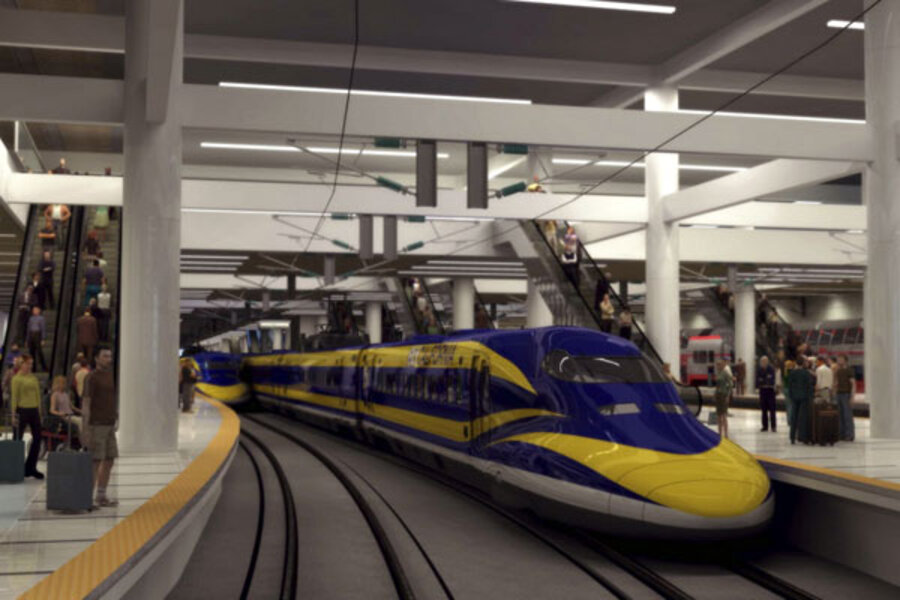After 20-year battle, protests over Italian high-speed train derail
Loading...
| Turin, Italy
Luca Abba, a farmer from Val di Susa, a valley that connects Italy to France, was electrocuted last February while climbing a high voltage pylon during protests against the construction of a new High Speed Railway Line (TAV) between Italy and France in a desperate attempt to resist expropriation.
He survived, though severe health problems persist. But the tragic incident was evidence of the tensions that have been rising for almost two decades between the valley’s local communities and the central government, culminating in violent clashes between protestors and contractors since construction finally began last summer. The project has become emblematic of a public works culture that is driven far more by politics than local need: the current rail connection is underused and environmental problems could arise.
In 1991, the Italian National Railway Co. first proposed construction of a high-speed rail line between Turin and Lyon, alongside the existing connection. It gave the green light to the project in 2001, despite reports of declining traffic of both people and goods between the two cities since 1997. Local inhabitants strongly oppose the megaproject, claiming environmental and economic reasons should prevent officials from continuing. Protests have been ongoing.
Highly toxic deposits of asbestos and uranium minerals would resurface during the building of tunnel, which “would cause environmental devastation,” says Nicoletta Dosio, a retired schoolteacher and co-founder of the movement against TAV. “The existing railway’s capacity is underused at around 20 percent: they should [first] use it.”
Conflict of interest
The high-speed railway saga fits into the narrative of Italy’s failed public works management, where business and politics often overlap. The long list of political scandals in Italy includes incidents involving the misappropriation of public funds, such as the SISMI-Telecom affair, which exposed government and corporate officials capitalizing on professional secrets that were obtained through wiretapping citizens' phone lines. The construction of the TAV has also exposed questionable business practices and nepotism.
The family-owned Gavio Group, head of the railway's general contractor Impregilo, was charged with corruption last July and accused of bribing Filippo Penati, former president of the province of Milan. CMC, a construction cooperative in Ravenna with close ties to the Democratic Party, was awarded the exploratory tunnel works, while Rocksoil, owned by the wife of the former center-right infrastructure minister Pietro Lunardi, won numerous contracts on the French side.
“There hasn’t been a parliament’s vote about TAV,” says Ugo Mattei, a professor of international and comparative law at the University of California in San Francisco. “There only is a law that dates back to 2001 that states the rules for every great infrastructure project to be realized between 2002 and 2013," leaving much leeway for politicians.
The “TAV is just the latest example of a transfer of public money in favor of private interest,” Mr. Mattei adds. “The Democratic Party’s favors to CMC make sense because the money is supporting the party indirectly."
Marco Ponti, professor of transport economics at the Polytechnic University of Milan and a World Bank consultant, says that there's no need for a new rail line connecting Turin with Lyon. “The traffic is very low, because Lyon is in the middle of nowhere: The existing line has a capacity of 20 tons of goods, and currently carries only three." He adds that the project "means enormous profits for builders and banks.”
A long history
Works were slated to begin in October 2005, but protesters have blocked them for years, literally chasing construction workers away. A few months later in December, the police nearly destroyed the local protest movement’s "No TAV" sit-in, after which 50,000 protesters attacked and destroyed the site.
Relations between the authorities and local people became so strained that the government formed a technical committee to negotiate with local mayors. In 2008, they reached an agreement to build the TAV, but many still disagreed. Insiders claim that the negotiations had not taken into account independent reports suggesting that the railway was dangerous for the environment and economically unsound.
Italy would have lost European funds if the works had begun later than June 2011, spurring the police to evacuate a new sit-in prompted by the renewed activity. The next month, 70,000 people occupied the area but were quickly dispersed. A series of fights, road blocks, and spontaneous demonstrations followed, causing the indictment of 42 people who were accused of inciting violence, inflicting personal injuries, and damaging public property. In an attempt to defuse the situation, the technical committee proposed a compromise. A cheaper and smaller rail line, consisting on just one tunnel, should reduce the cost to 3 billion euros, it said.
Unhappy ending
This lower-cost project has not been without its critics.
A number of professors at the Polytechnic University of Turin stated in a report that the revised proposal lacks a proper analysis of its economic sustainability. “[T]he government says there will be no environmental damages, either direct or indirect. That’s wrong: any kind of work, big or little, will generate some impact, and in this case the danger posed by asbestos deposits has been played down.”
In May 2012, local elections in Val di Susa turned into a referendum on the railway. The Democratic Party and Silvio Berlusconi's Freedom Party joined forces by presenting candidates supporting the project, but were still defeated by candidates from the No-TAV movement in many towns.
Meanwhile, construction continues and critics remain skeptical. “Nobody will transport its goods by trucks to trains: loading times are too long,” Mr. Ponti sighed.







